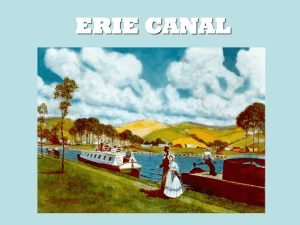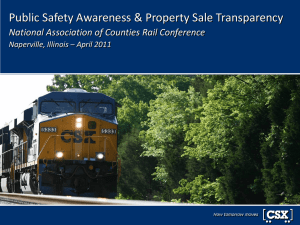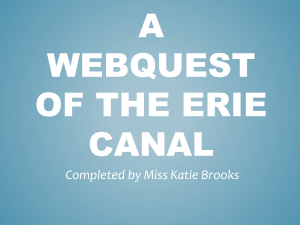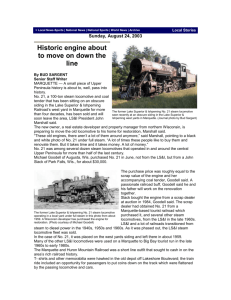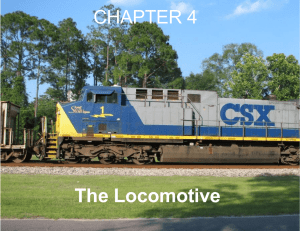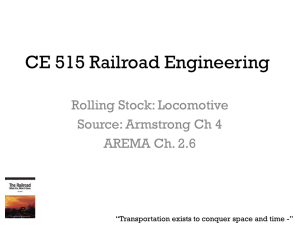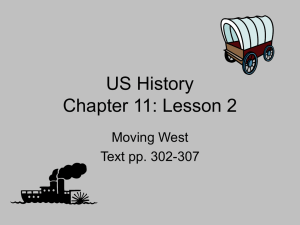Transportation and moving west ppt
advertisement
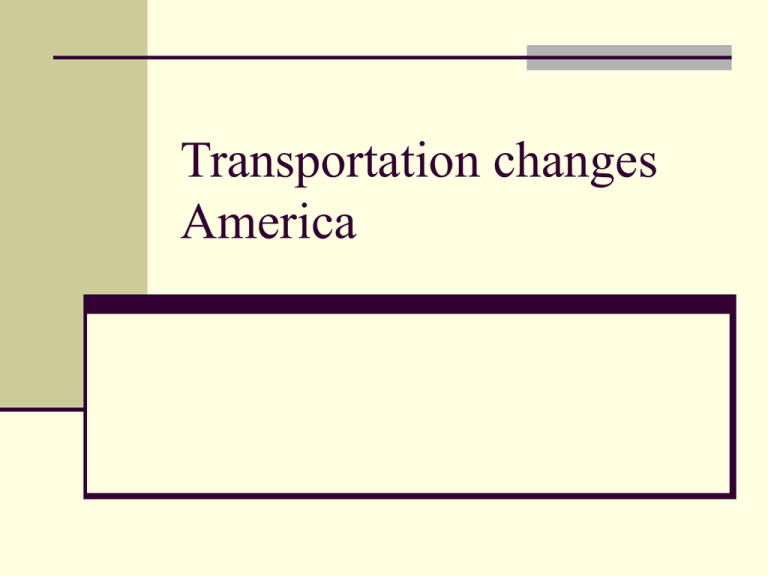
Transportation changes America Population Moving West A. Counting of the population was called Census a. US population in 1790 was nearly 4,000,000 b. US population by 1820 had grown to 10,000,000 Roads and turnpikes A. Toll roads built and used to move west were called Turnpikes B. Corduroy roads were Roads made from logs The Fairview Inn near Baltimore, a stopping place on the National Road, 1827 National Road National Road or Cumberland Road The National Road or Cumberland Road was the first major improved highway in the United States to be built by the federal government. a. Funded in 1806 b. Construction began heading west in 1811 at Cumberland, Maryland, on the Potomac River. It crossed the Allegheny Mountains and southwestern Pennsylvania, reaching Wheeling, West Virginia), on the Ohio River in 1818. c. From Cumberland to Vandalia Illinois Plans were made to continue through St. Louis, at confluence of the Mississippi and Missouri Rivers, and to Jefferson City upstream on the Missouri. Following the panic of 1837 however, funding ran dry and construction was stopped at Vandalia, Illinois, after crossing the states of Ohio and Indiana. Beyond the National Road's eastern terminus at Cumberland and toward the Atlantic coast, a series of private turnpikes were completed in 1824, connecting the National Road with Baltimore, Maryland and its port on Chesapeake Bay; The approximately 620-mile (1,000 km) long National Road provided a connection between the Potomac and Ohio Rivers and a gateway to the West for thousands of settlers. It was the first road in the U.S. to use the new macadam road surfacing. Single-sized aggregate layers of stone with a coating of binder as a cementing agent are mixed in an open-structured macadam Construction of the first macadamized road in the United States (1823). In the foreground, workers are breaking stones "so as not to exceed 6 ounces in weight or to pass a two-inch ring River travel A. Travel in east was difficult because a. Most major rivers flowed in a North – South direction b. Traveling upstream against the current was slow and difficult Robert Fulton Steam Travel James Rumsey, John Fitch early experiments Robert Fulton hired to build steamship to go from New York to Albany Cleremont The Cleremont was 140 ft long and 14 ft wide In 1807 it traveled from NY to Albany (150 mi) in 32 hours compared to 4 days by sail Canals Artificial Rivers Dewitt Clinton wanted to link NY City to the Great Lakes Erie Canal 363 miles -Proposed in 1808 and completed in 1825, the canal links the waters of Lake Erie in the west to the Hudson River in the east. An engineering marvel when it was built, some called it the Eighth Wonder of the World. Erie Canal It included 18 aqueducts to carry the canal over ravines and rivers, and 83 locks, with a rise of 568 feet from the Hudson River to Lake Erie. It was 4 feet deep and 40 feet wide, and floated boats carrying 30 tons of freight. A ten foot wide towpath was built along the bank of the canal for the horses and/or mules which pulled the boats and their driver, often a young boy (sometimes referred to by later writers as a "hoggee"). In order to keep pace with the growing demands of traffic, the Erie Canal was enlarged between 1836 and 1862. The "Enlarged Erie" was 70 feet wide and 7 feet deep, and could handle boats carrying 240 tons. The number of locks was reduced to 72. Railroads The railroad was first developed in Great Britain. A man named GEORGE STEPHENSON successfully applied the steam technology of the day and created the world's first successful locomotive. The first engines used in the United States were purchased from the STEPHENSON WORKS in England. Even rails were largely imported from England until the Civil War It is interesting, in conclusion, to take a bird's- eye view of the early development of the railroads after the construction of the Granite Railway of Quincy, the first railroad in America. B & O Railroad In 1828, ground was broken for the Baltimore and Ohio Railroad, and on August 8, 1829, the first steam locomotive, "The Stourbridge Lion," was used in transportation by the Delaware and Hudson Company. The locomotive earned the name Lion from the picture of a lion's face that was painted on the front of the locomotive by its builder. The Stourbridge portion of the name is from the town of Stourbridge in England, where the locomotive was manufactured.. Baltimore and Ohio Railroad Baltimore, the third largest city in the nation in 1827, had not invested in a canal. Yet, Baltimore was 200 miles closer to the frontier than New York and soon recognized that the development of a railway could make the city more competitive with New York and the Erie Canal in transporting people and goods to the West. Tom Thumb On August 28, 1830, the Baltimore and Ohio Railroad opened and Peter Cooper's "Tom Thumb," the first American steam locomotive to run on American railroads, was successfully operated New railroads came swiftly. In 1830, the SOUTH CAROLINA CANAL AND RAIL-ROAD COMPANY was formed to draw trade from the interior of the state. It had a steam locomotive built at the West Point Foundry in New York City, called THE BEST FRIEND OF CHARLESTON, the first steam locomotive to be built for sale in the United States. On November 2, 1830, "The Best Friend of Charleston" made its successful trip on the South Carolina Railroad. The "West Point" was the second locomotive built in the United States for service on this same railroad, and its trial trip was on March 5, 1831 The West Point Mohawk & Hudson A year later, the Mohawk & Hudson railroad reduced a 40-mile wandering canal trip that took all day to accomplish to a 17-mile trip that took less than an hour. Its first steam engine was named the DeWitt Clinton after the builder of the Erie Canal. On August 9, 1831, the "De Witt Clinton," the first locomotive to draw passenger cars ever run in the State of New York, made its first excursion trip, and from this early day on the story of the development of the railroad system in America fills volumes. Although the first railroads were successful, attempts to finance new ones originally failed as opposition was mounted by turnpike operators, canal companies, stagecoach companies and those who drove wagons. Western Settlement How did better transportation affect westward expansions? It shortened the travel time reduced the cost and made travel more comfortable which made westward movement more attractive
